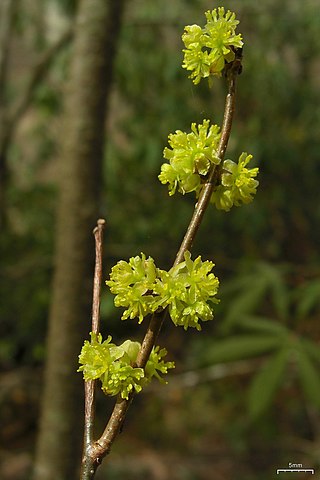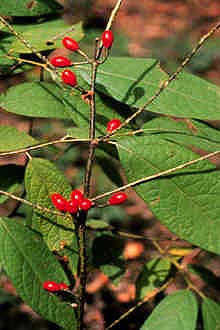
Ilex opaca, the American holly, is a species of holly, native to the eastern and south-central United States, from coastal Massachusetts south to central Florida, and west to southeastern Missouri and eastern Texas.

Plant reproductive morphology is the study of the physical form and structure of those parts of plants directly or indirectly concerned with sexual reproduction.

Lindera benzoin is a shrub in the laurel family. It is native to eastern North America, ranging from Maine and New York to Ontario in the north, and to Kansas, Texas, and northern Florida in the center and south. Within its native range it is a relatively common plant where it grows in the understory in moist, rich woods, especially those with exposed limestone.

Salix pentandra, the bay willow, is a species of willow native to northern Europe and northern Asia. The scientific name refers to the male flowers having five stamens. The English name derives from the resemblance of the leaves to those of the bay laurel; other common names include bay-leaved willow and laurel willow. Its glossy leaves make it more decorative than many other willows, so it is often planted as an ornamental tree.

Salix cinerea is a species of willow native to Europe and western Asia.

A flower, also known as a bloom or blossom, is the reproductive structure found in flowering plants. Flowers consist of a combination of vegetative organs – sepals that enclose and protect the developing flower, petals that attract pollinators, and reproductive organs that produce gametophytes, which in flowering plants produce gametes. The male gametophytes, which produce sperm, are enclosed within pollen grains produced in the anthers. The female gametophytes are contained within the ovules produced in the carpels.

Vaccinium ovatum is a North American species of flowering shrub known by the common names evergreen huckleberry, winter huckleberry, cynamoka berry and California huckleberry. Vaccinium ovatum is classified in phylum: Magnoliaphyta, order: Ericales, family: Ericaceae, genus: Vaccinium, and species: ovatum.

Cornus amomum, the silky dogwood, is a species of dogwood native to the southern Ontario and eastern United States, from Michigan and Vermont south to Alabama and Florida. Other names include red willow, silky cornel, kinnikinnick, and squawbush.
This page provides a glossary of plant morphology. Botanists and other biologists who study plant morphology use a number of different terms to classify and identify plant organs and parts that can be observed using no more than a handheld magnifying lens. This page provides help in understanding the numerous other pages describing plants by their various taxa. The accompanying page—Plant morphology—provides an overview of the science of the external form of plants. There is also an alphabetical list: Glossary of botanical terms. In contrast, this page deals with botanical terms in a systematic manner, with some illustrations, and organized by plant anatomy and function in plant physiology.

Frangula alnus, commonly known as alder buckthorn, glossy buckthorn, or breaking buckthorn, is a tall deciduous shrub in the family Rhamnaceae. Unlike other "buckthorns", alder buckthorn does not have thorns. It is native to Europe, northernmost Africa, and western Asia, from Ireland and Great Britain north to the 68th parallel in Scandinavia, east to central Siberia and Xinjiang in western China, and south to northern Morocco, Turkey, and the Alborz in Iran and the Caucasus Mountains; in the northwest of its range, it is rare and scattered. It is also introduced and naturalised in eastern North America.

Rhus copallinum, the winged sumac, shining sumac, dwarf sumac or flameleaf sumac, is a species of flowering plant in the cashew family (Anacardiaceae) that is native to eastern North America. It is a deciduous tree growing to 3.5–5.5 metres (11–18 ft) tall and an equal spread with a rounded crown. A 5-year-old sapling will stand about 2.5 metres (8.2 ft).

Sapria himalayana, commonly known as the hermit's spittoon, is a rare holoparasitic flowering plant related to Rafflesia found in the Eastern Himalayas. Sapria himalayana represents the extreme manifestation of the parasitic mode, being completely dependent on its host plant for water, nutrients and products of photosynthesis which it sucks through a specialised root system called haustoria. These haustoria are attached to both the xylem and the phloem of the host plant.

Lindera melissifolia, common name pondberry or southern spicebush, is a stoloniferous, deciduous, aromatic shrub in the laurel family. This endangered species is native to the southeastern United States, and its demise is associated with habitat loss from extensive drainage of wetlands for agriculture and forestry. Restoration efforts are currently being conducted.

Populus ciliata, the Himalayan poplar, is a large deciduous tree with tall clean straight trunk and wide rounded crown. The bark of the young trees is smooth greenish-grey and the bark of the old trees is dark brown with vertical cracks. Leaves are broadly ovate with serrulate-crenate and hairy margins. Flowers are drooping raceme catkins appear before or with leaves. Populus ciliata flowers are dioecious, individual flowers are either male or female. Perianth of male flowers is bell-shaped and female flowers are bluntly toothed. Their capsule encloses an average of 100–150 seeds, which are covered by long silky hair.

Adenodaphne is a genus of shrubs and small trees endemic to New Caledonia belonging to the family Lauraceae. The genus is related to Litsea. They have 12 chromosomes.
Dodecadenia is a botanical genus of flowering plants in the family Lauraceae. It contains a single species, Dodecadenia grandiflora. It is present from central Asia, to Himalayas and India. It is present in tropical and subtropical montane rainforest, laurel forest, in the weed-tree forests in valleys, mixed forests of coniferous and deciduous broad-leaved trees, Tsuga forests; 2,000–2,600 metres (6,600–8,500 ft) in China in provinces of Sichuan, Xizang, Yunnan, and countries of Bhutan, India, Myanmar, and Nepal.
Aspidostemon is a genus of flowering plants belonging to the family Lauraceae. It occurs in Madagascar.

Rubus flagellaris, the northern dewberry, also known as the common dewberry, is a North American species perennial subshrub species of dewberry, in the rose family. This dewberry is distributed across much of Canada, Mexico, and the United States. It grows in diverse habitats ranging from drier savannas to temperate deciduous forests.

Salix mesnyi is a species of willow native to southern and eastern China, Taiwan, and Vietnam. It can be found among shrubs near water growing 15 metres (49 ft) tall.

Hypericum patulum, known as goldencup St. John's wort or yellow mosqueta, is a species of flowering plant in Hypericumsect. Ascyreia.



















